My first pipit photos of the year.
When I posted a single photo of an American Pipit three days ago I was surprised by how many of my readers said they’d never seen one. So today I decided to share a few more photos and some information about them.
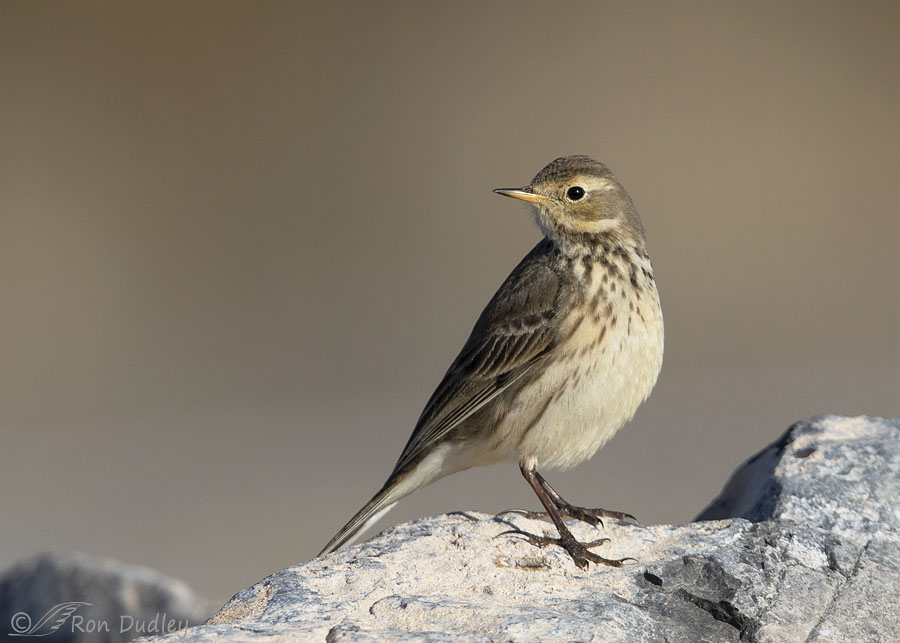
1/2500, f/6.3, ISO 320, Canon 7D Mark II, Canon EF 500mm f/4L IS II USM + EF 1.4 III Extender, not baited, set up or called in
I’ve been hearing pipits and seeing small flocks of them in flight for several weeks now but until four days ago I had zero success with them. On that morning, near the Bear River, I spent some time with a few pipits as they cavorted on a rock pile.
They were usually at least partially side lit but when they’d turn at just the right angle to the sun I could…
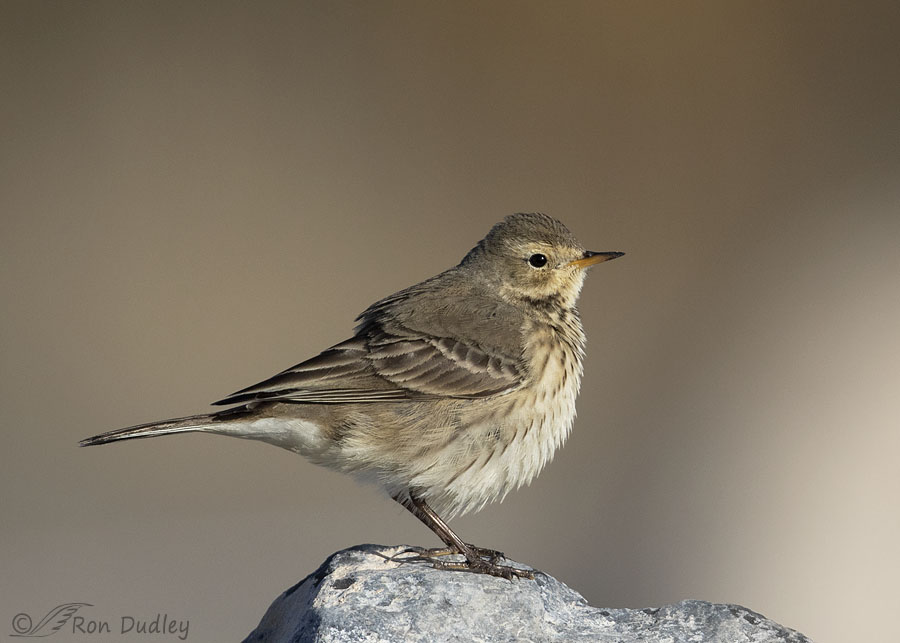
1/4000, f/6.3, ISO 500, Canon 7D Mark II, Canon EF 500mm f/4L IS II USM + EF 1.4 III Extender, not baited, set up or called in
get even light on almost their entire body. Not that side light is necessarily a bad thing.
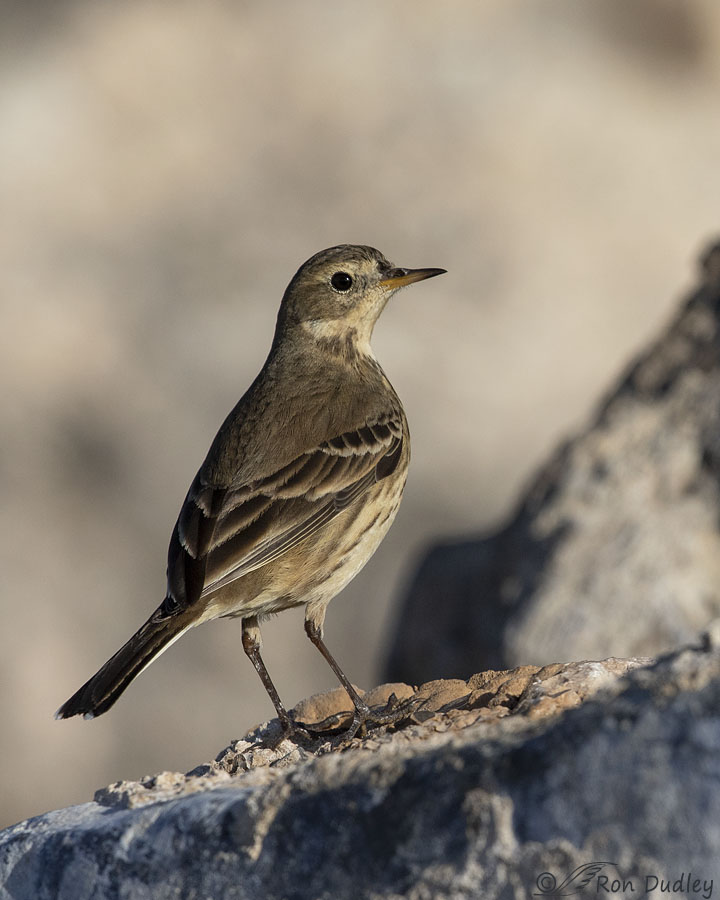
1/3200, f/8, ISO 500, Canon 7D Mark II, Canon EF 500mm f/4L IS II USM + EF 1.4 III Extender, not baited, set up or called in
This one came in very close and even though it turned it’s back to me it compensated by giving me a nice head turn.
Most of these photos are presented in the order I took them. It was with this bird that I changed my aperture setting to f/8 in order to have a little more depth of field because the bird was so close and I forgot to change it back. So all of the rest of the photos were taken at an aperture I wouldn’t have chosen. No big deal but it’s still operator error.
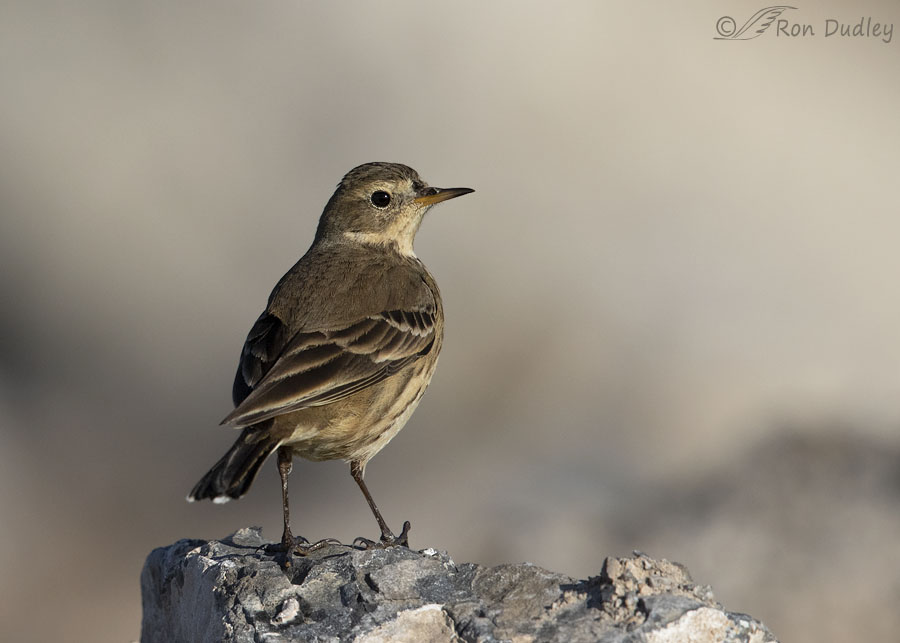
1/3200, f/8, ISO 500, Canon 7D Mark II, Canon EF 500mm f/4L IS II USM + EF 1.4 III Extender, not baited, set up or called in
Similar pose, different perch. Soon after this shot was taken the pipit…
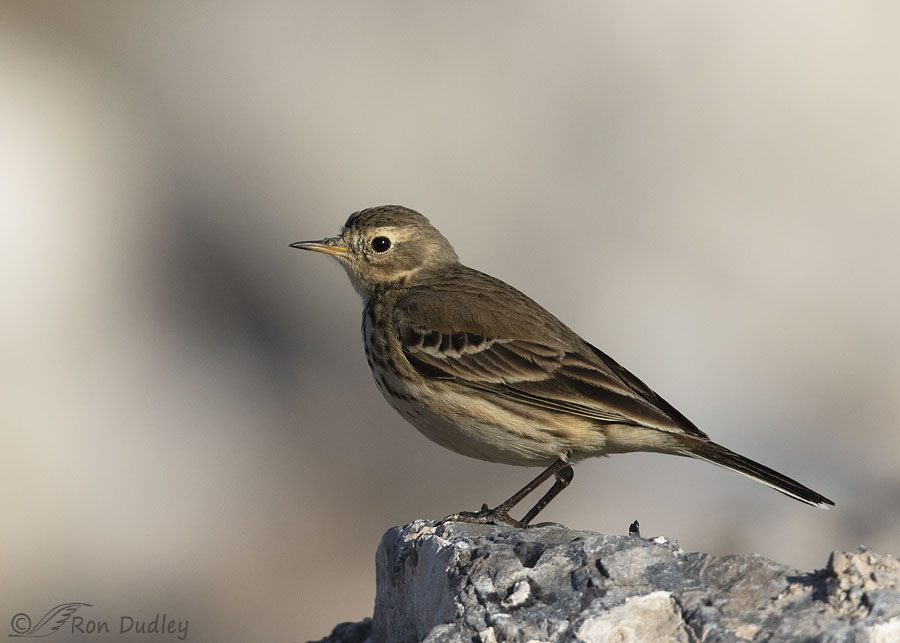
1/3200, f/8, ISO 500, Canon 7D Mark II, Canon EF 500mm f/4L IS II USM + EF 1.4 III Extender, not baited, set up or called in
turned on its perch to give me a different look.
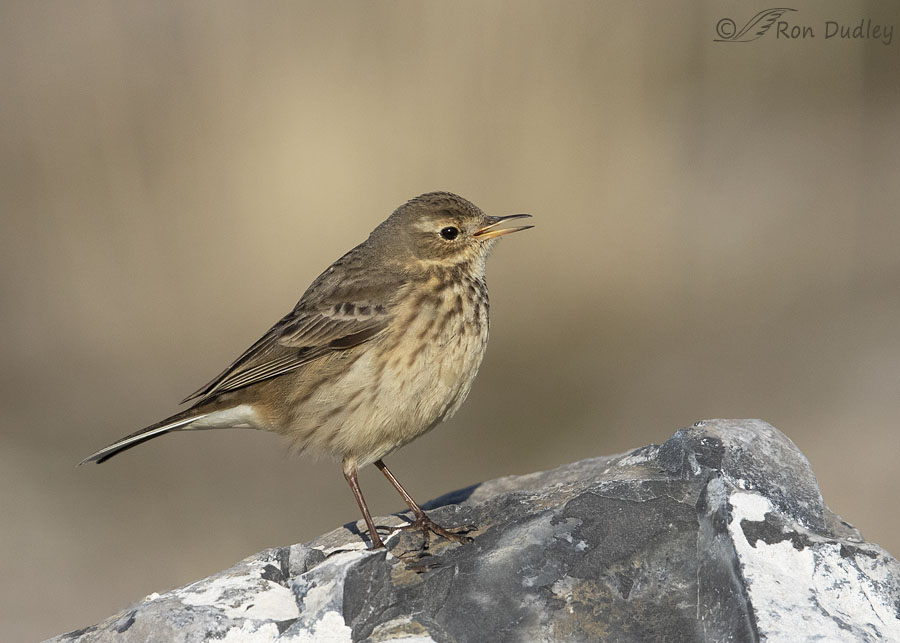
1/3200, f/8, ISO 500, Canon 7D Mark II, Canon EF 500mm f/4L IS II USM + EF 1.4 III Extender, not baited, set up or called in
Occasionally one of them would call as this one’s doing but their calls are often so soft and high-pitched I sometimes have difficulty hearing them.
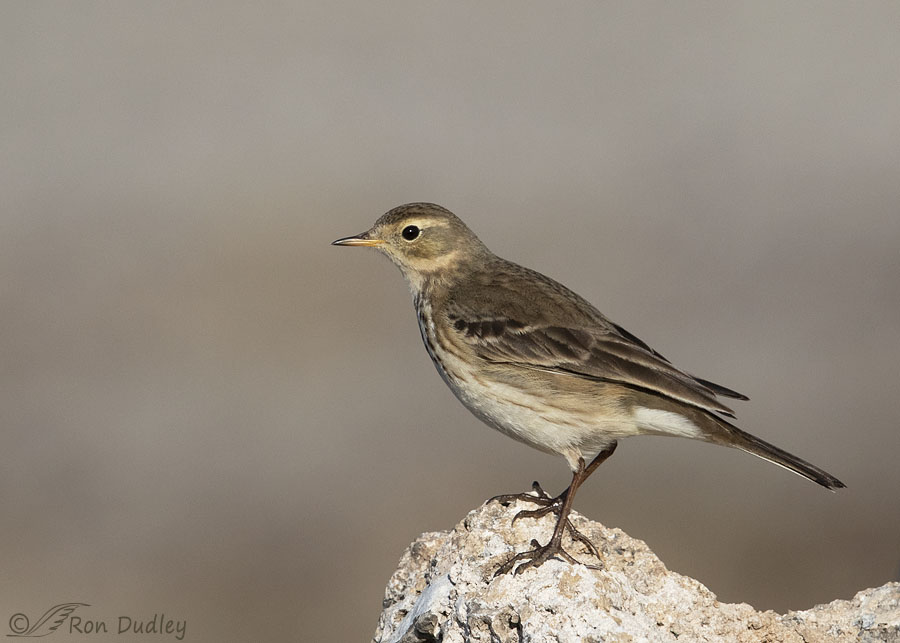
1/3200, f/8, ISO 500, Canon 7D Mark II, Canon EF 500mm f/4L IS II USM + EF 1.4 III Extender, not baited, set up or called in
One last look at an American Pipit.
Some pipit factoids:
- American Pipits are inconspicuous migratory songbirds that occur throughout North America, although in many areas they’re only seen during migration.
- Pipits of various species are found on all continents except Antarctica.
- American Pipits were called Water Pipits for many years.
- The American Pipit is is one of the very few species of ground-inhabiting songbirds that breed at high altitudes on the inhospitable arctic tundra.
- It’s estimated that about 20 million American Pipits exist but their numbers have decreased by about 30% since the 1970’s.
If you’re one of those who have never seen American Pipits, now you know what to look and listen for.
Ron


Any guess why the hallux is so long in the pipit?
Such a beautiful little bird! I think I had several pass through my yard a week or so ago. I love the third photo with the nice head turn. I will be looking for more pipets in my yard now that I know what I am seeing and hearing. I always learn something new from your blog, Ron.
Good to know, Melanie. Thank you.
I am in a fairly cynical state of mind so the first thing I thought when I read that they were down 30% was “I hope someone cares for the pitpit as much as they do the whales.”
They really are quietly elegant!
Arwen, I understand that cynical state of mind thing. These days it comes with the times.
The clarity of these images is incredible. It’s inspiring to be able to see such detail in living birds in their natural states.
Besides “water pipits” I’ve also heard the common name “wagtails” which aptly describes a common behavior I witnessed in the flocks I first saw gathered around a temporary pond created by a heavy downpour outside my classroom window.
Yup, wagtail is another common name for them Jim. Some of them were doing just that while I was photographing them.
Thank you — and your readers — for all the information about American Pipits. Now I’m wondering if I have actually seen them at the spca. They have a lovely little fish pond/waterfall feature that one of the employees created about 20 years ago. The pond attracts all kinds of birds (one of the reasons I’m trying to convince the powers that be to keep it). All these little guys are so quick, but I now have a couple more ID markers to look for — if they’d only stand still for a minute!
I am also drawn to the 3rd shot, in part because of the graceful lines of the bird and also in part because of the interesting rock features. I can say the same of the last shot — bird and rock.
I hope they keep the fish pond, Marty. And that you spot a pipit or two near it.
My favorite – the first picture with that remarkable hallux. Until 20 minutes ago I knew not the pipit and my only knowledge of the hallux was wrapped up with the inglorious bunion. The things you teach us Ron.
“The things you teach us Ron”
Made me smile, Frances. Technically our big toe is our hallux. The hallux of birds points backward.
Thanks for all the Pipit poses. I think I now have a pretty good chance of ID. The long hallux helps and the stripes above and below seeming to put the eye in parentheses seems a helpful characteristic as well.
“The eye in parentheses” – Seems to me that’s a good field mark, Lyle. I’m going to remember that one.
Hi Ron,
A loverly series – the first image is my favourite.
A timely post and comment about the distribution of pipits as I had just been out photographing an Australasian Pipit here in New Zealand.
Best wishes
Thanks, Gary. Now I’m gonna have to do a little research on your Australasian Pipit. At least enough to find out what it looks like and its range.
Agree with Nancy – the 3rd shot is my fav. Wonderful series and the lighting is gorgeous! Love when you show the backs of birds so we can enjoy their wing patterns and colors! Have never seen a Pipit!
“Love when you show the backs of birds so we can enjoy their wing patterns and colors”
I like that kind of shot too, Kathleen – as long as I get an acceptable head turn and a catch light in the eye.
Well, they are handsome little birds and, although I’m sure I’ve not seen one before (or at least not properly ID’d one), eBird tells me they can be found nearby in winter so I’ll be on the lookout now. And keep my ears open.
I do like the first image best (were I asked to choose) because of the rock perch, the blend of lighter background colors and the light on the bird. And, of course, that nice pose. Thanks for the expanded introduction!
“were I asked to choose”
Chris, I always like to know which of my images viewers prefer. Please continue mentioning it whenever you like.
Lovely series, I really like the third over the back look, but that is one of my favorite poses. I see them in St George area often, the pipits there have pinkish chest and stomach feathers. I can’t decide if it is reflected light from the red dirt or staining from the red dirt when they dust bathe.
April, it sounds to me like the pipits you’re seeing down there are one of the other North American subspecies. Here’s what Cornell has to say about r alticola (notice the last little bit about pinkish color).
“Breeds in the Rocky Mts. from Montana south to e.-central Arizona and n. New Mexico and, farther west, chiefly in the Sierra Nevada of California, although known north to se. Oregon and south to the San Bernardino Mts. in s. California [type locality = Estes Park, Colorado]; winters in the sw. United States and nw. Mexico. Body size large (wing chord > 85 mm); ventral streaking reduced, often absent or nearly so across the breast; malar patch indistinct or lacking; in alternate plumage, ventrum rich pinkish or cinnamon-pink.”
Thanks, Ron.
Thank you for more photos of this subtle charmer. Not only have I not seen it, I probably never will (in the flesh and feathers).
Thanks, EC.
The light and everything else on the 3rd photo is my favorite. Nice series.
Thank you, Nancy.
Today’s photos are a good illustration of something I learned as a young art student many years ago : When presented in good lighting and placed with
respect and care within the composition, every feature of the humblest and plainest of subjects becomes captivating and will assume an aspect of dignity and be worthy of regard……. I admire these modest Pipits ! Thanks for the
reminder !
And thanks for the introduction to a concept that I agree with but have never seen stated so eloquently.
Cute little birds. We have them scampering around a couple of our lakes usually in low numbers and mostly during transition times.
Today is the 80th anniversary of the attack on Pearl Harbor. I was 3 years 8 months and a few days old so was not quite ready to enlist.
I wasn’t born until after my dad got back from participating in the invasion of Okinawa (radioman and flame thrower operator) and after “the bombs” were dropped on Japan he had occupation duty in Korea. I didn’t make my appearance until May of 1947 so I wasn’t quite ready to enlist either…
Wow Ron – your dad was really in it for sure. I was a radioman in the Navy for 5 years, but no hostilities during my service. Hard to even imagine what guys like your dad went through. I have two younger twin bros born in 47.
He was the radioman because he was tall so it was easier for him to get a signal out. The flip side was that, for obvious reasons, the Japanese soldiers always tried to shoot the radioman first and that long antenna stuck up like a sore thumb. He told me once that he felt like a sitting duck.
It was close to impossible to get him to talk about it. I wish that hadn’t been the case but I certainly understand.
Love the shots! Superb in my mind!
Thanks very much, Dick.
“Think” I’ve heard them but, if I saw any, I didn’t realize what they were… subtly pretty bird that would easily disappear into the surroundings. REALLY long back toe!
subtly pretty bird that would easily disappear into the surroundings. REALLY long back toe!
On another note in 40 years or so of using bird netting I’ve never had one get tangled – until now. A Grey Crowned Rosy Finch got a leg caught and proceeded to twist. My lighter allowed me to “cut” around the netting and untangle the foot. Didn’t appear broken tho took awhile for it to function well again. GEEZ! All I can figure is I usually don’t have it up in fall/winter (Robins – the main berry culprit) but left it to keep the White tail deer off things. Lesson learned!
“REALLY long back toe”
Good eye, Judy. I very nearly posted a closeup shot of that extended toe (hallux). Probably should have..
Real nice images. Background is great. Include me with those who have never seen one.
Thank you, Bruce. Apparently you’re far from alone.
I once spent over an hour watching a Pipit hunt for Stone Fly larvae in a Canadian Rocky Mountain stream. Repeatedly diving beneath the surface. Completely distracted me from any thoughts of trout. There is beauty everywhere, if we bother to look for it.
That must have been fun. Not many fisherpersons I know would allow a bird to distract them from fishing for that long. Good on ya, Porcupine.
It makes me so happy to see them because “pipit” has been an oft-used crossword puzzle word and even though I put the letters in the squares I never knew what one looked like!!!
That’s great, Sue! One never knows when a bit of trivia might come in handy.